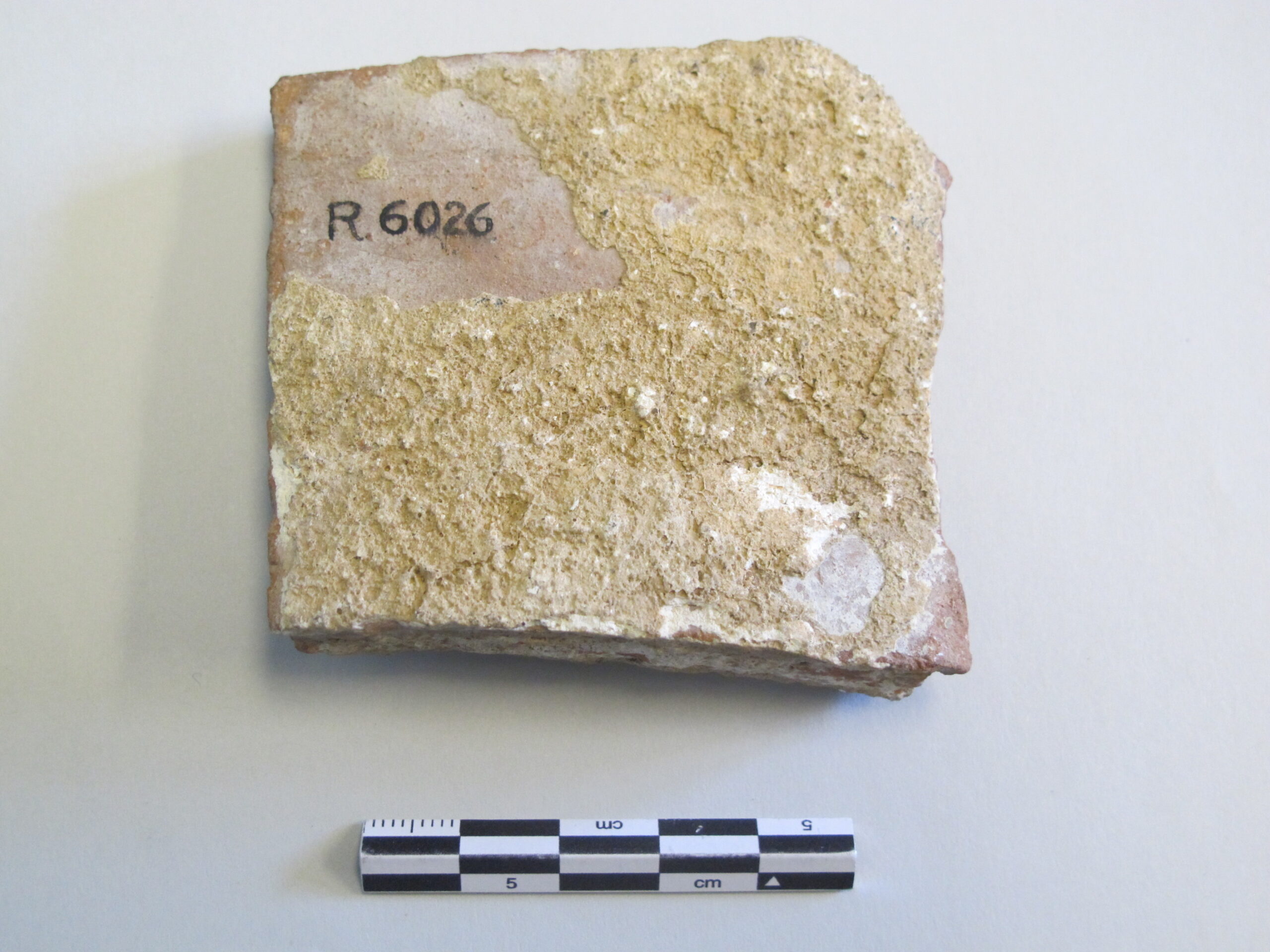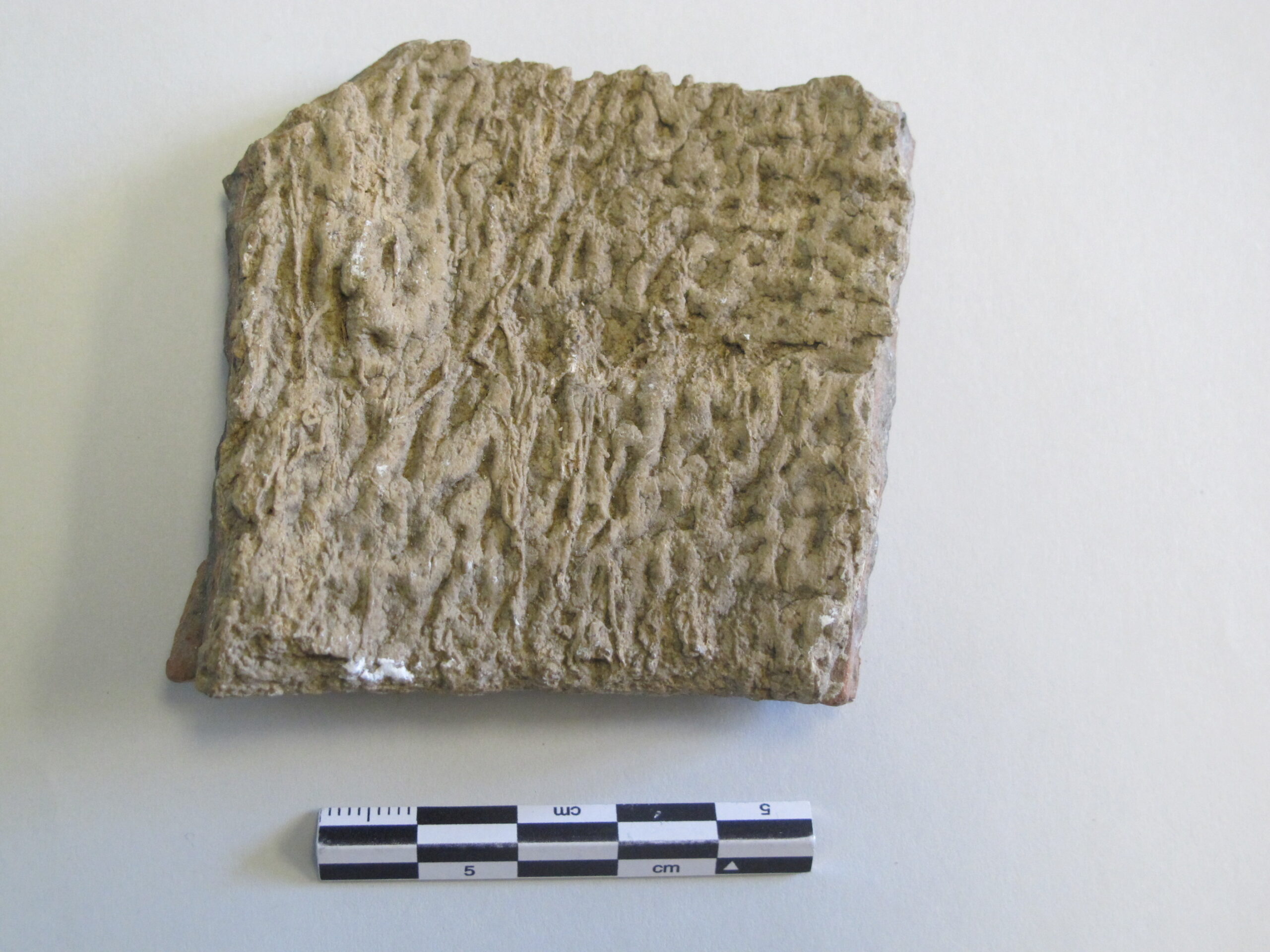For a 3D model made by the Virtual Curation Lab at Virginia Commonwealth University, see https://skfb.ly/orZCK
Pipe fragment
AWG0000.01.15
Roman
Roman period (100-350 CE?)
Material: Terracotta, mineral deposit (lime, lead, etc.)
Weight: 101g
Dimensions: 6.6 cm tall, 6 cm high, 1 cm wide
Condition: All edges are broken; some wear and encrustation on the exterior; heavy mineral build-up on the interior
Provenance: Unknown
Source/donor: Unknown
Date of acquisition: Probably before 1932
Other notes: The old inventory number (R6026) suggests that it was part of the Richmond College Museum collection. Other R-numbered items were displayed in the Biology Museum in Maryland Hall beginning in 1932.
Research by: Julia Berutti ‘23
Detailed description of form/shape:
Dark red fabric with dark gray core. The interior is covered with a thick layer of wavy, rigid mineral deposits, light gray in color.
Comparanda:
For the general shape of a full piece, see Wellcome Collection “Pottery water pipe, Roman, 100-350 CE “. For pipes joined together, see Hodge 1992, figs 67, 68, 69. For examples of Roman lead pipes, see British museum 1860,1002.96 and 1860,1002.99.
Discussion:
This pipe fragment is interesting for a number of reasons. First, it offers a glimpse into a mistake in the manufacturing process: the dark gray band that runs right through the core of the red terracotta pipe indicates that it had not been fired thoroughly. Also noteworthy is the pipe’s wavy, rigid interior surface. After extended use, minerals like calcium, lead, and limestone that were present in the water supply began to build up within Roman pipes.. It was buildup like this in pipes, particularly those made of lead, that actually protected the Romans from lead poisoning (Scharping 2017). It was not uncommon for terracotta pipes to have up to half an inch of buildup (Hodge 1992, 25).
Terracotta pipes were used in Hellenistic Greece and around the Roman Empire, especially in Anatolia (Hodge 1992, 12). The pipes would normally be around 20-25cm in diameter and 40-70cm in length and were not completely cylindrical, so that the joints could easily slide together. They were often smaller than pipes made of other materials, like wood or lead, because of the limitations of a potter’s wheel (Hodge 1992, 25, 113)
Though Roman hydraulic systems like aqueducts are particularly famous, Romans were not the first to construct complex pipe systems. Before the first Roman water projects were the aqueduct at Jerwan in the city of Nineveh around the 8th century BCE as well as the Peisistratean, Hymettos, and Acharnian aqueducts that existed in Athens from the 6th to 4th century BCE (Deming 2019, 152-153). The first great achievements of Roman plumbing was the Cloaca Maxima, which was constructed in Rome around 510 BCE. The massive plumbing system was installed in Rome and was used to drain marshes and direct waste water into the Tiber River (Marsalek 2005, 1). Pliny the Elder even regarded the public sewers as a “work more stupendous than any” (Natural History 36.24). It was this first achievement that began a centuries-long dedication to plumbing improvement in the Roman Empire. By the Agustan age, beginning around 43 BCE, intricate plumbing systems, mostly consisting of lead pipes, carried water in and out of many private homes in Rome, Pompeii, and Roman cities in North Africa. These pipe systems served not only utilitarian purposes of cooking, drinking, washing, etc., but it also displayed the wealth, innovation, and power of the empire and individuals (Koloski-Ostrow 73).
Bibliography:
The British Museum. “Water-Supply-Pipe | British Museum.” Accessed September 30, 2021. https://www.britishmuseum.org/collection/object/G_1860-1002-99.
The British Museum. “Water-Supply-Pipe | British Museum.” Accessed September 30, 2021. https://www.britishmuseum.org/collection/object/G_1860-1002-99.
Scharping, Nathaniel.“Roman Pipes Delivered Water — And Toxic Antimony.” Discover Magazine, 17 August 2017. Accessed September 30, 2021. https://www.discovermagazine.com/planet-earth/roman-pipes-delivered-water-and-toxic-antimony.
Hodge, A. Trevor. Roman Aqueducts & Water Supply. London: Duckworth, 1992.
Koloski-Ostrow, Ann Olga. The Archaeology of Sanitation in Roman Italy: Toilets, Sewers, and Water Systems. Studies in the History of Greece and Rome. Chapel Hill: The University of North Carolina Press, 2015.
Marsalek, Jiri. “Evolution of Urban Drainage: From Cloaca Maxima to Environmental Sustainability.” In Acqua E Citta. I Convegno Nazionale Di Idraulica Urbana, 1–22. Sant’Agnello, 2005.
Wellcome Collection. “Pottery Water Pipe, Roman, 100-350 CE.” Accessed September 30, 2021. https://wellcomecollection.org/works/qner244k.


